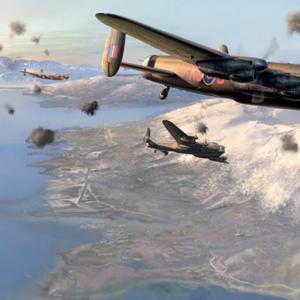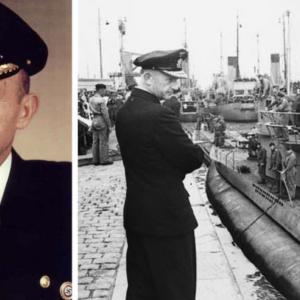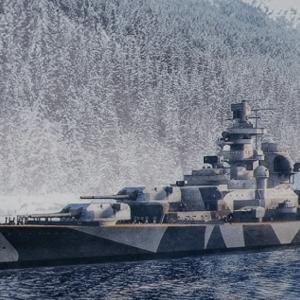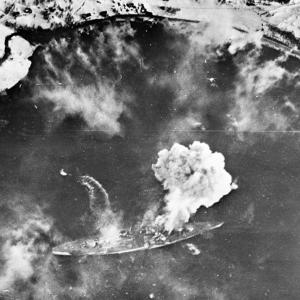
On this day in military history…
In November 1944, after years of frustration and repeated attempts, the Royal Air Force finally succeeded in destroying the German battleship Tirpitz, one of the most powerful and feared warships ever built. The sinking of the Tirpitz marked the culmination of a long and determined campaign by the Allies to neutralize a vessel that had tied up immense resources simply by existing. Conceived as the sister ship to the Bismarck, the Tirpitz had spent most of the war lurking in Norwegian fjords, a constant threat to Allied convoys bound for the Soviet Union and a symbol of Nazi naval power. Its presence forced the British Admiralty to keep a large portion of the Royal Navy stationed in northern waters, ready to respond if it ever sortied. Prime Minister Winston Churchill made its destruction a personal priority, insisting that the ship “must be destroyed at all costs.”
The RAF’s success in finally sinking the Tirpitz came only after a long series of operations by both the Fleet Air Arm and the Royal Air Force. Earlier missions, including daring midget submarine attacks in 1943 and several heavy bomber raids in 1944, had damaged but failed to sink the battleship. Each time, the Tirpitz was battered, patched up, and towed further north to a new anchorage, first to Altenfjord and later to Tromsø. This resilience earned her the nickname “The Lonely Queen of the North.” By late 1944, however, Churchill’s patience had worn thin. He pressed Bomber Command for a decisive operation, one that would end the Tirpitz threat once and for all.
That final strike came under the codename Operation Catechism, carried out on 12 November 1944. The operation was planned under the direction of Air Chief Marshal Sir Arthur “Bomber” Harris, head of RAF Bomber Command, and executed by two of its elite units: No. 617 Squadron, the famous “Dambusters,” and No. 9 Squadron. The attack was led in person by Group Captain James Tait, who had taken part in several of the earlier attempts and now commanded the operation with meticulous precision.
For this mission, 32 Avro Lancaster bombers were assigned—29 of which reached the target. Each aircraft carried one of Barnes Wallis’s remarkable 12,000-pound “Tallboy” deep-penetration bombs, the same design used against German U-boat pens and V-weapon sites. These bombs were engineered to burrow deep into the ground or through armor before detonating, creating a devastating shockwave capable of destroying even the most heavily protected targets.
The bombers took off from bases in northern Scotland, flying a long and treacherous route across the North Sea. To avoid German radar, they flew low until approaching the Norwegian coast, then climbed to bombing altitude as they neared Tromsø Fjord. The weather was crucial to success—previous raids had failed due to cloud cover—but on 12 November the skies were clear and the visibility perfect. As the Lancasters approached, the Tirpitz lay fully exposed in the fjord, anchored as a floating gun platform and surrounded by snow-covered mountains.
The first bombs fell with deadly accuracy. Several near misses shook the ship, but at least two Tallboys struck home. One penetrated near the bridge and detonated deep inside, while another exploded amidships. Within minutes, massive explosions tore through the vessel, fires spread uncontrollably, and the Tirpitz began to list rapidly to port. Just ten minutes after the first impact, she capsized completely, trapping over 900 of her crew inside the overturned hull. The once-proud flagship of the German Navy now lay upside down in shallow water, a shattered relic of Nazi sea power.
Remarkably, all 32 Lancasters returned safely to base, an achievement that spoke to the precision of the planning and the professionalism of the crews. Operation Catechism was a total success—swift, conclusive, and devastating. For Bomber Command, it was a rare moment of satisfaction and vindication. The success demonstrated that strategic bombing, often criticized for its human toll on cities, could achieve precise and decisive results against a major military target.
The impact on morale was immediate and profound. In Britain, the news of the Tirpitz’s destruction was celebrated as a triumph. It ended years of anxiety over a ship that had symbolized a constant menace to Allied shipping. For the aircrews involved, it was a mission that brought immense pride and relief, proof that persistence and precision could prevail where brute force had failed.
In Germany, the loss of the Tirpitz was a severe blow to the Kriegsmarine and to Hitler himself, who had already lost confidence in his surface fleet. Its destruction marked the end of Germany’s capital ship era. From that day on, the German Navy was confined to defensive and coastal operations, with the Tirpitz’s wreck lying as a stark reminder of what Allied air power could achieve.
Thus, on 12 November 1944, Operation Catechism closed one of the most determined chapters of the war at sea. Years of failed attacks and near misses culminated in a single, flawless strike that sent the last great battleship of the Third Reich to the bottom. It was a feat of planning, technology, and courage—an operation that symbolized the relentless resolve of the RAF and the Allies to finish what they had begun.










